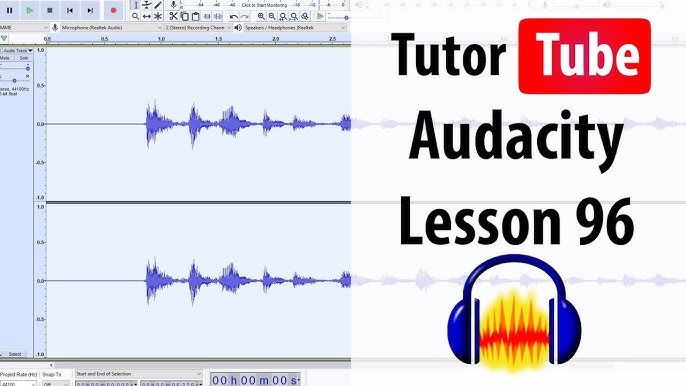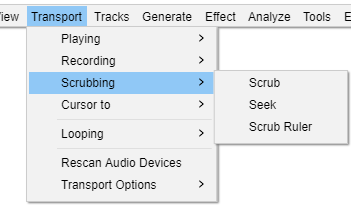Scrubbing in Audacity is a way to preview audio quickly. It lets you listen to parts of a track without playing the entire clip.
This feature is useful for editing and fine-tuning your audio projects. Scrubbing allows you to move through audio files efficiently. It helps you find specific spots in a track with ease. This feature is especially handy for removing unwanted noise or making precise cuts.
In this blog post, we will explore how scrubbing works in Audacity. You’ll learn how it can improve your audio editing skills. Whether you’re a beginner or experienced user, understanding scrubbing can make your work smoother and faster. Let’s dive into the details and see how this tool can benefit your audio projects.

Credit: www.youtube.com
Introduction To Scrubbing
In the world of audio editing, precision is key. Audacity, a popular audio editing software, offers various tools to ensure this precision. One of these tools is called scrubbing. But what exactly is scrubbing, and why is it important for your audio projects?
What Is Scrubbing?
Scrubbing is a technique used in Audacity that allows you to move through your audio file slowly. This helps you locate specific points in the audio. It’s like rewinding or fast-forwarding a tape but with more control. You can hear the audio as you scrub, making it easier to find exact spots to edit.
Importance Of Scrubbing
Scrubbing is crucial for detailed audio editing. It helps you:
- Identify precise points for cuts or edits.
- Locate unwanted noise or errors in the audio.
- Ensure seamless transitions between audio segments.
Without scrubbing, you might miss small but important details. This can affect the overall quality of your audio project.
How Scrubbing Works
Scrubbing in Audacity is a useful feature for audio editing. It helps you locate specific parts in your audio track. The process mimics moving a tape reel back and forth. This way, you hear a short segment of the audio. Let’s dive into how scrubbing works.
Basic Mechanism
Scrubbing allows you to move through your audio track. You click and drag the mouse over the waveform. This action plays a short loop of the audio. The loop helps you identify the precise point you need to edit. The faster you drag, the faster the audio plays. Slower dragging gives you more control. This helps in pinpointing exact moments. Scrubbing can be done forwards or backwards.
Key Features
Audacity’s scrubbing feature offers useful options. You can adjust the speed of scrubbing. This lets you listen at different playback rates. There is also a choice between two types of scrubbing. One is the “Standard Scrub,” which loops a small section of audio. The other is “Scrub Ruler,” which shows the position in the timeline.
Another key feature is the ability to pause scrubbing. You can stop and start at any time. This is useful for detailed work. Audacity also provides visual cues during scrubbing. The cursor changes shape to indicate scrubbing mode. These features make scrubbing a powerful tool for audio editing.
Benefits Of Scrubbing
Scrubbing in Audacity is a useful feature for audio editing. It allows users to preview and navigate through audio files efficiently. Understanding the benefits of scrubbing can greatly enhance your audio editing experience.
Enhanced Precision
Scrubbing provides enhanced precision in audio editing. It lets you pinpoint exact locations in an audio file. This is crucial for tasks like removing noise or aligning tracks.
- Locate specific sounds or words
- Make precise edits
- Achieve cleaner cuts
With scrubbing, you can easily find the right moment to edit. This reduces errors and improves the overall quality of your work.
Improved Workflow
Scrubbing also leads to improved workflow. By using scrubbing, you save time navigating through long audio files. This allows you to focus on creative aspects rather than repetitive tasks.
- Quickly navigate through audio files
- Identify problem areas faster
- Spend less time on mundane tasks
Overall, scrubbing makes the editing process more efficient. It allows you to work faster and with more accuracy.
By incorporating scrubbing into your editing routine, you can improve both precision and workflow. This makes Audacity a more powerful tool for audio editing.

Credit: manual.audacityteam.org
Scrubbing Techniques
Scrubbing in Audacity is a technique used to navigate audio tracks. It allows users to play audio at different speeds to find specific points. This method helps in precise editing and improves workflow efficiency.
Standard Scrubbing
Standard scrubbing lets you drag the playhead along the timeline. This action enables you to hear the audio at normal speed. It helps in locating specific sections quickly. Follow these steps for standard scrubbing:
- Open Audacity and load your audio file.
- Click and drag the playhead on the timeline.
- Listen to the audio at standard speed.
This method is useful for quick navigation.
Audio Scrubbing
Audio scrubbing allows for more advanced navigation. It plays audio at variable speeds as you move the playhead. Use audio scrubbing to pinpoint exact moments in your track. Here is how you can use audio scrubbing:
- Open your project in Audacity.
- Hold the Shift key and click the playhead.
- Drag the playhead to scrub through the audio.
- Adjust the speed by moving the playhead faster or slower.
Audio scrubbing provides precise control over audio editing.
| Technique | Key Actions | Benefits |
|---|---|---|
| Standard Scrubbing | Drag playhead | Quick navigation |
| Audio Scrubbing | Hold Shift, drag playhead | Precise control |
Using Scrubbing In Audacity
Scrubbing in Audacity is a useful feature that allows you to navigate through your audio tracks with ease. This technique makes it simpler to find specific parts of your recording. By using scrubbing, you can listen to sections in real-time and make precise edits. Let’s explore how to use this feature effectively.
Step-by-step Guide
First, open your audio file in Audacity. Next, find the Scrubbing tool in the toolbar. It looks like a hand or play button. Click on it to activate.
Now, click and drag your mouse over the waveform. This action will play the audio at the speed you move your mouse. Moving faster will speed up the playback. Moving slower will slow it down.
Release the mouse button to stop scrubbing. You can repeat this process to find other parts of your audio. This tool helps you make precise cuts and edits.
Tips And Tricks
Use short, quick movements for small adjustments. This helps you find exact spots in your audio. For longer sections, drag the mouse further to cover more ground.
Adjust the playback speed by changing your drag speed. Slow down for detailed edits. Speed up for a quick overview.
Practice using the scrubbing tool to get comfortable. The more you use it, the easier it becomes to navigate your audio tracks.
Remember to save your work often. This prevents loss of any changes you make.

Credit: www.youtube.com
Common Issues And Solutions
Scrubbing in Audacity can be an invaluable tool for precise editing. Yet, it can sometimes present challenges that hinder productivity. Below, we explore common issues and their solutions to enhance your experience.
Troubleshooting Tips
Facing issues with scrubbing? You’re not alone. Here are some troubleshooting tips:
- Lagging Audio: Ensure your computer meets Audacity’s system requirements.
- Scrubbing Not Starting: Check if scrubbing is enabled in the preferences.
- Erratic Playback: Update your Audacity version to the latest.
These steps can resolve most common issues quickly.
Avoiding Common Mistakes
To avoid frequent mistakes, keep these tips in mind:
- Wrong Tool Selection: Make sure you select the scrub tool before starting.
- Excessive Zooming: Zooming in too much can make scrubbing less effective.
- Ignoring Preferences: Customize scrubbing settings in the preferences for better control.
Avoiding these mistakes can streamline your editing process in Audacity.
Advanced Scrubbing Features
Audacity offers advanced scrubbing features that help you navigate audio files smoothly. These features enhance your editing experience. Let’s explore some of these advanced options.
Looping
Looping allows you to play a section of audio repeatedly. This helps in detailed editing. You can set the start and end points of the loop. This feature is useful for tasks like fixing small errors or analyzing specific parts of the audio. The loop feature ensures you stay focused on the exact section you need.
Speed Control
Speed control lets you adjust the playback speed. You can slow down or speed up the audio. This is great for transcribing or learning a piece of music. Slowing down can help you catch every detail. Speeding up can save time during long edits. The speed control feature adds flexibility to your editing process.
Frequently Asked Questions
What Is Scrubbing In Audacity?
Scrubbing in Audacity allows users to navigate audio by dragging the cursor. It helps in precise editing.
How Do You Scrub In Audacity?
To scrub in Audacity, click and drag the cursor in the Timeline. This lets you hear the audio while moving.
Why Use Scrubbing In Audacity?
Scrubbing aids in locating specific audio sections quickly. It’s useful for editing, making the process efficient.
Can Scrubbing Improve Audio Editing?
Yes, scrubbing improves audio editing by providing precise control. It allows better identification of edit points.
Conclusion
Scrubbing in Audacity is a simple yet powerful tool. It helps in precise audio editing. You can easily locate and edit specific sections. This feature saves time and effort. Beginners and experts find it useful. Try it out for better control over your audio projects.
Happy editing with Audacity!
{ “@context”: “https://schema.org”, “@type”: “FAQPage”, “mainEntity”: [ { “@type”: “Question”, “name”: “What is scrubbing in Audacity?”, “acceptedAnswer”: { “@type”: “Answer”, “text”: “Scrubbing in Audacity allows users to navigate audio by dragging the cursor. It helps in precise editing.” } } , { “@type”: “Question”, “name”: “How do you scrub in Audacity?”, “acceptedAnswer”: { “@type”: “Answer”, “text”: “To scrub in Audacity, click and drag the cursor in the Timeline. This lets you hear the audio while moving.” } } , { “@type”: “Question”, “name”: “Why use scrubbing in Audacity?”, “acceptedAnswer”: { “@type”: “Answer”, “text”: “Scrubbing aids in locating specific audio sections quickly. It’s useful for editing, making the process efficient.” } } , { “@type”: “Question”, “name”: “Can scrubbing improve audio editing?”, “acceptedAnswer”: { “@type”: “Answer”, “text”: “Yes, scrubbing improves audio editing by providing precise control. It allows better identification of edit points.” } } ] }